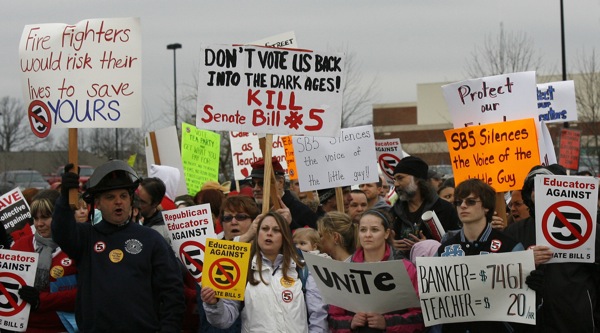Kasich's Collective Bargaining Fumble

In just a few hours, the polls in Ohio will close and we will begin to discover whether John Kasich’s signature initiative--Senate Bill 5, which ends collective bargaining rights for public sector unions--has survived the consistent attacks on it by the Ohio Democratic Party.
Specifically, the electorate will have a chance to vote on Issue 2 on the Ohio ballot. A vote for the issue will keep Senate Bill 5 in place and vindicate Kasich. A vote against it will repeal SB 5 and repudiate him.
Most observers aren’t optimistic that Issue 2 will pass (Jim Geraghty calls the outlook “grim”), and given the polls, that’s probably wise. Progressives will probably claim this proves that Kasich’s leadership mandate is nonexistent and that the idea was foolhardy politics and bad policy to begin with.
They’re wrong on both counts.
When Kasich came into office, he was riding a wave of anti-public sector resentment. According to a poll done that July by the Buckeye Institute, 85 percent of Ohioans supported making the Buckeye State a right-to-work state and 43 percent preferred cutting public sector employee compensation over 36 percent for cutting spending and 16 percent for raising taxes. It was this mass resentment that gave Kasich the edge he needed to eke out his 2 point victory over Ted Strickland.
Lurking in these statistics is the key to understanding why Issue 2 is flagging in the polls. Kasich could have gone the more “radical” way and made Ohio a right-to-work state and had 85 percent of the electorate behind him, or he could have gone the more moderate way of just cutting public employee benefits and still had a plurality of support. The former measure he could have tied to job growth and attracting employers. The latter he could have justified on the grounds of public sector spending.
Instead, Kasich tried to turn the comparatively moderate course into a bold one by cutting benefits and removing the right of public sector workers to bargain them back up. So far, so good, but how did he justify it? By talking about job growth and attracting employers. In other words, Kasich took what was basically a fiscal measure needed to trim Ohio’s budget and tried to clumsily tie it to job growth, which was an unrelated issue.
This played right into the hands of unions, who easily seized on the idea that even if SB 5 would create jobs, they wouldn’t be jobs worth having because the employees, no matter who they were, couldn’t negotiate their way up from getting dog biscuits for a salary. Kasich tried to counter a la Scott Walker. This too fell flat.
Why? Because unlike Scott Walker, Kasich couldn’t counter that it was only useless public sector bureaucrats who’d feel the sting of his law – police and firemen were also targeted, and no one is going to agree that either group is useless.
As a result, rather than the Democrats being blamed for using a comparatively small subset of workers to claim victimhood for all workers everywhere, Kasich ended up being tarred for claiming he was only attacking a small subset of workers, when really his agenda could hurt everyone by taking cops off the streets or letting their houses burn down. This combined with Kasich’s hard-hitting, take-no-prisoners style made for a singularly unattractive picture.
In short, if Issue 2 fails today, it will not be Kasich’s fault for proposing bad policy. Nor will it be a repudiation of the national GOP, as Issue 3, which attacks Obamacare, looks likely to pass. The only way to explain SB 5’s failure is to state plain and simply that Ohio Republicans chose the wrong arguments to defend the right policy.

